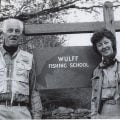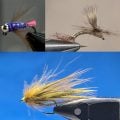How to Tie a Light Cahill Klinkhamer
Producer: Tim Flagler
The Light Cahills have started to show in numbers here in New Jersey. They really are beautiful-looking bugs and have become one of my favorite hatches. This Klinkhamer is supposed to represent a winged Light Cahill dun emerging from its nymphal shuck while suspended in the surface film. You almost feel sorry for these guys as they’re finally emerging as adults and just barely get a wing free before being eaten by a hungry trout. It’s neat to watch when it happens with enough daylight to actually see, but here in New Jersey anyway, that’s rare. Most of the time the hatch and the spinner fall take place right at dark, and a good bit after. It’s sometimes difficult to see your fly on the water, but the results can be spectacular.
This Light Cahill Klinkhamer begins with a Partridge Klinkhamer X-treme hook in size 14. After getting the hook firmly secured in the jaws of my tying vise, I load a bobbin with a spool of cream UTC 70 Denier. Get your thread started on the hook shank behind the eye and take a few wraps rearward before snipping off the excess tag. Continue wrapping for a short ways down the hook shank then back up to just shy of the little kink in the hook.
For visibility and floatation, it’s hard to beat white polypropylene floating yarn for the fly’s wing post. Snip a card-width segment free from the card. Place one end of the yarn over top of your tying thread and take nice, tight rearward wraps to secure it. While maintaining your grip on the end of the yarn, snip it off at a shallow angle, which will help to taper the body of the fly. Take thread wraps rearward building a smooth ramp down to the hook shank then wraps back up to the little kink.
Get hold of the yarn and twist it in a clockwise direction as if you’re looking down on it. Really twist it up well. Bring the loose end down to the hook shank allowing the twisted-up yarn to furl on itself. Pinch the yarn against the hook shank and take tight thread wraps rearward to secure it. You can then lift the end up and snip it off at an angle. Cover the butts with wraps of tying thread then relocate your thread down the shank until it hangs at about the hook point.
Although there are many materials that can be used for the body or trailing shuck of the fly, depending on how you look at it, I really like rust-colored Antron dubbing, because of its shimmer and translucency. Use the dubbing to create a very slender 3” long noodle on your tying thread. Start taking wraps so the dubbing begins well down into the hook bend, then make slightly overlapping wraps up the shank to create a nicely tapered body. End with bare tying thread immediately in front of the wing post.
A white or cream-colored hackle feather from a dry fly neck is used for the parachute. It’s always a good idea to first measure the feather to make sure it’s the appropriate size, here, a perfect 14, before pulling it free from the skin. With the shiny side of the feather facing you, strip away all the lower, webby fibers from both sides of the stem. Strip a few extra fibers from the top edge of the stem to help the feather wrap correctly. Then flip the feather over so its dull side faces you.
Lay the feather against the wing post with bare stem going about 1/8” up the post. While keeping that position, anchor the stem to the near side of the hook with tight wraps of tying thread, then snip the excess off close. Take thread wraps back to the base of the post then pull the hackle feather up to vertical and begin taking wraps around both the stem and the wing post. Once you’re about 1/8” up, take nice smooth thread wraps back down. Make sure to do a full wrap or two around the hook shank to save your posting work.
Cream-colored rabbit fur is used to look like the body of the winged adult emerging from its nymphal shuck. A small pinch is all you need. Use the dubbing to create a very slender 1 1/2” long noodle on your tying thread. Take wraps with the noodle to cover up all the exposed thread wraps on the hook shank then end with your tying thread on the near side of the hook, in front of the post.
Get hold of the hackle feather and start taking wraps with it. Try to get that extra little bare part of the stem to contact the post first. Continue taking touching wraps with the feather down the wing post until you reach the body of the fly. Secure the feather there with 3 or 4 tight thread wraps, right at the base of the post. Once again, end with your tying thread on the near side of the hook, in front of the post. Reach in with the tips of your tying scissors and carefully snip any trapped hackle fibers, on the near side of the fly, off close. You can then get hold of your whip finish tool and use it to do a 4 or 5 turn, vertical whip finish at the base of the post. Make sure to seat the knot well, then snip or cut your tying thread free.
Now, check the far side of the fly for trapped hackle fibers and, if there are any, snip them off close. A drop of head cement, here Sally Hansen Hard as Nails, applied to the exposed thread wraps will ensure they don’t come unraveled, and greatly increase the durability of the fly. As a final step, snip the top of the wing post off and fluff it out to look like an emergent wing or wings.
And that’s the Light Cahill Klinkhamer. I really like how the body of the fly hangs below the water’s surface while the hackle fibers keep the fly from sinking. The white poly wing post makes the fly quite visible, even well into dark.
How to Tie a Less Mess Morrish Mouse
How to Tie a Light Cahill Parachute











